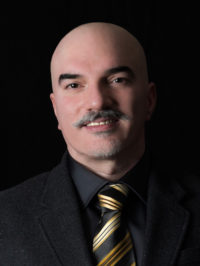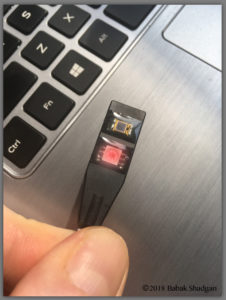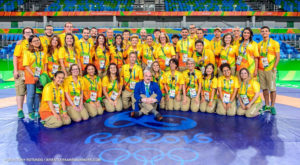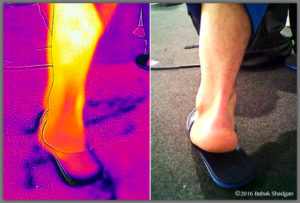
Principal Investigator
M.D. (Tehran Azad University)
M.Sc. [Sports Medicine] (University of London)
Ph.D. [Muscle Biophysics] (University of British Columbia)
Fellowship [Diffused Optical Tomography] (MIT/Harvard University)
Postdoctoral Fellowship [Clinical Biophotonics] (University of British Columbia)
Scholar, Michael Smith Foundation for Health Sciences (MSFHR)
Assistant Professor, Department of Orthopaedics, UBC
Lecturer, School of Biomedical Engineering, UBC
Research Scientist, Vancouver Prostate Centre
Scientific Staff, Vancouver Acute (Vancouver General Hospital)
Instructor and Senior Member, SPIE
Research Interests
Bio-sensing; Clinical Biophotonics; Musculoskeletal and sports medicine; Near-infrared spectroscopy; Neuroprotection; Translational researchDr. Shadgan’s primary research is focused on using biophotonics techniques to study processes occurring inside tissues, including their supplies of blood and oxygen, in a clinical setting. The core of his current research program includes developing a new method for continuous monitoring of spinal cord hemodynamics and oxygenation in people with acute spinal cord injury (SCI). In collaboration with ICORD PI Dr. Brian Kwon, Dr. Shadgan has developed an implantable NIRS sensor small enough to be placed over the spinal cord for non-invasive monitoring of spinal cord tissue oxygenation and hemodynamics. He is also developing an optical sensor to assess and monitor blood flow to grafts, as well as their viability in reconstructive surgery and organ transplantation.

A miniaturized multi-wavelength NIRS sensor developed by Dr. Shadgan for continuous monitoring of tissue oxygenation and hemodynamics.
Among photonics techniques, Dr. Shadgan has expertise and a particular interest in development and application of near-infrared spectroscopy (NIRS) in clinical settings. NIRS works by transmitting light energy (photons) in the near-infrared spectrum (wavelengths ~ 650-1000 nm) into living tissue, then monitoring the absorption of photons by the molecules in the tissue that give it colour. NIRS can track changes in oxygen supply, consumption and demand in tissues, and it is non-invasive, which means that it doesn’t have to be inserted through the skin. NIRS can be used to measure changes in the amount of oxygen and blood entering tissues in real-time. When using different wavelengths of light and varying distance from the tissue, NIRS can also measure the ratio of oxygenated blood to total blood in the tissue, which is known as tissue oxygenation index (TOI%). This index is important in clinical settings because it does not need to be compared to other measures in order to provide rapid, real-time information on the level of oxygen in tissues. Analysis of NIRS signals can also provide useful information about other properties of tissues. This is especially important in the acute phase of SCI, when a lack of blood flow and oxygen in the spinal cord can cause further damage to it. Improving blood flow and oxygenation of the spinal cord in the acute stage of SCI can prevent a significant degree of neural damage, thus mitigating the health conditions that the SCI causes. Dr. Shadgan is determined to use his research program, funded by an MSFHR Scholar Award in 2018, to make discoveries that improve the quality of life for people with SCI.
As a sports physician-scientist, Dr. Shadgan is also a pioneer researcher in applying photonics techniques to the evaluation and monitoring of skeletal muscle metabolism and function during exercise and when affected by injuries. Using modifications of wireless and wearable NIRS systems, Dr. Shadgan explores the quality of muscle contraction and recovery in high-performance athletes as well as in people with neuromuscular and muscle fatigue conditions. He is also developing applications of infrared Imaging techniques for non-invasive evaluation of skeletal muscle injuries.
Olympic experiences have played a critical role in shaping Dr. Shadgan’s research career since 2002. During the 2004 Athens Olympic Games, one of his patients, a gold medalist wrestler, had to drop out of Olympic competitions because of progressive leg pain caused by a condition called chronic exertional compartment syndrome (CECS). In contrast to the majority of medical conditions, which are challenging to manage, treatment of this syndrome is straightforward when an early diagnosis is made. The standard diagnosis is based on clinical assessment confirmed by measurement of the leg’s intra-compartmental pressures, an invasive technique that requires inserting multiple needles into the leg compartments and recording intra-compartmental pressure changes while the subject runs on a treadmill. Difficult and subjective, this method often has limited diagnostic values. Many people, especially elite athletes, refuse to undergo this kind of investigation simply because of its invasive nature. That Olympics experience inspired Dr. Shadgan to start investigating an alternative, non-invasive, and sensitive technique for early and accurate diagnosis of CECS. He came to UBC with a clinical proposal to use NIRS for this purpose.
 Dr. Shadgan’s second area of interest in sports medicine is injury prevention and Olympic injury surveillance studies. His studies are focused on better understanding of the characteristics, risk factors and mechanisms of injuries in athletes from the recreational to elite level, and in high-risk individuals including people with disabilities. As the chairman of the International Olympic Wrestling Federation Medical Commission, Dr. Shadgan has been serving the Olympic Games as a Medical Officer and Medical Director of Wrestling competitions since the 2004 Athens Olympic Games.
Dr. Shadgan’s second area of interest in sports medicine is injury prevention and Olympic injury surveillance studies. His studies are focused on better understanding of the characteristics, risk factors and mechanisms of injuries in athletes from the recreational to elite level, and in high-risk individuals including people with disabilities. As the chairman of the International Olympic Wrestling Federation Medical Commission, Dr. Shadgan has been serving the Olympic Games as a Medical Officer and Medical Director of Wrestling competitions since the 2004 Athens Olympic Games.
The multidisciplinary and spinal cord research-oriented environment of ICORD provides a unique opportunity for Dr. Shadgan’s research program. He enjoys working with exceptional researchers, scientists and trainees with a variety of skills and areas of expertise at ICORD, where he is establishing his state-of-the-art clinical biophotonics laboratory.
Recent collaborations
Dr. Shadgan collaborates with numerous ICORD researchers, including Dr. Brian Kwon, with whom he investigates applications of NIRS to monitoring blood flow in the acutely injured spinal cord, and Dr. Aziz Ghahary, with whom he studies wound healing by infrared imaging. Dr. Shadgan has collaborated with Drs. Mark Nigro and Lynn Stothers on NIRS-based monitoring of bladder muscle hemodynamics, pressure and function in people with SCI.
Major Findings
- Near-infrared spectroscopy (NIRS) is a viable technique for monitoring tissue hemodynamics and oxygenation in the spinal cord
- NIRS can be used for non-invasive diagnosis of skeletal muscle conditions related to oxidative damage, fatigue, and dysfunction
- NIRS can be used for non-invasive monitoring of detrusor muscle hemodynamics and pressure in people with neurogenic bladder and SCI. A configuration of NIRS can be used for rapid and non-invasive diagnosis of acute urinary tract infection (UTI) in paediatrics
Techniques Employed in the Lab
- Near-infrared spectroscopy (NIRS)
- Photoplethysmography (PPG)
- Biosensing sensors
- Infrared imaging
Affiliations with Organizations
- Department of Orthopaedics, Faculty of Medicine, University of British Columbia
- School of Biomedical Engineering, Faculty of Applied Sciences, University of British Columbia
- Vancouver Coastal Health Research Institute (VCHRI)
- Canadian National Transplant Research Program (CNTRP)
- Canadian Orthopaedic Association (COA)
- International Society for Optics and Photonics (SPIE)
- Texas Instruments Expert Advisory Panel
- Society for Neuroscience (SFN)
- Medical & Anti-Doping Commission, International Olympic Wrestling Federation (UWW)
Awards
- Clinical Trial Award, US Department of Defense Research Program (2021)
- Wall Solutions Award, Peter Wall Institute for Advanced Studies (2020)
- Scholar Award, Michael Smith Foundation for Health Sciences (2018)
- Innovator’s Challenge Award, VGH & UBC Foundation (2018)
- Innovation and Translational Research Award, Vancouver Coastal Health Research Institute (2017)
- Innovator’s Challenge Award, Lumira Capital (2017)
- Post-Doctoral Fellowship, Canadian Institute of Health Research (2013)
- Post-Doctoral Fellowship, University of Calgary – Eye’s High Program (2013)
- Wearable Technology Innovation World Cup (2012)
- Post-Doctoral Fellowship, Michael Smith Foundation for Health Sciences (2011)
- D.J. Lovell Award, International Society of Photonics and Optics (2010)
- Rising Star Award, Vancouver Coastal Health Research Institute (2009)
- Senior Graduate Trainee Award, Michael Smith Foundation for Health Sciences (2007)
- Respiratory Rehabilitation Fellowship, British Columbia Lung Association (2006)
- Best Thesis Award, Queen Mary College, University of London (2001)
- AO-ASIF Fellowship, AO International Orthopedic Foundation (1998)
Trainee Awards
Year |
Name |
Award |
| 2022 | Katharina Raschdorf | ICORD Best Poster Award |
| 2021 | Leili Ghazizadeh | ICORD Best Poster Award |
| 2021 | Aaron Mah | ICORD Best Poster Award |
| 2021 | Farnaz Ghazizadeh | ICORD Best Poster Award |
| 2021 | Amanda Cheung | 1st Place Presentation (UBC, Science Communication Conference) |
| 2021 | Amanda Cheung | Publication of the Year (UBC, Neuroscience) |
| 2021 | Justin Wyss | UBC Three-Minute-Thesis (3MT) (Top 5 Ranking) (UBC) |
| 2021 | Justin Wyss | SBME Three-Minute-Thesis (3MT) (2nd Place & People’s Choice) (UBC Faculty of Applied Science & UBC School of Biomedical Engineering) |
| 2020 | Leili Ghazizadeh | Postdoctoral Fellowship (MITACS) |
| 2020 | Amanda Cheung | Education Renewal Grant (UBC) |
| 2020 | Amanda Cheung | 3rd Place Poster Presentation (ICORD, Trainee Symposium) |
| 2020 | Amanda Cheung | 2nd Place Podium Presentation (Future of Health Research Day) |
| 2020 | Amanda Cheung | President’s Academic Excellence Initiative PhD Award (UBC) |
| 2020 | Amanda Cheung | SPIE Optics and Photonics Education Scholarship (International Society for Optics and Photonics) |
| 2020 | Amanda Cheung | Vanier Canada Graduate Scholarship (CIHR) |
| 2020 | John Madden (for Justin Wyss’ research project) | WorkSafeBC Innovation at Work Research Grant (WorkSafe BC) |
| 2020 | Justin Wyss | Faculty of Applied Science Graduate Award (UBC Faculty of Applied Science & UBC School of Biomedical Engineering) |
| 2020 | Justin Wyss | President’s Academic Excellence Initiative Ph.D. Award (UBC) |
| 2020 | Justin Wyss | International Tuition Award (UBC) |
| 2020 | Justin Wyss | Western Economic Diversification Canada (WD) Funding Award (Simon Fraser University) |
| 2020 | Justin Wyss | Dr. Donald, Eleanor & Laurie Rix Biotechnology Graduate Scholarship (Simon Fraser University) |
| 2020 | Justin Wyss | UBC Applied Science Rising Star (UBC Faculty of Applied Science) |
| 2020 | Justin Wyss | Innovation UBC Start-Up Idea Competition 2nd Place (Innovation UBC) |
Current Lab Members
Masters Students |
PhD Students |
Research Staff |
| Farnaz Sahragard | Katharina Raschdorf | Dr. Ali Zaidi |
| Aaron Mah | Garrett Frank | Dr. Mahsa Khalili |
| Jensen Colton | Shahbaz Askari | Mehdi Noorizadeh |
| Mehdi Noorizadeh | Saud Lingawi | Sadra Khosravi |
| Justin Wyss | ||
| Reza Alemy |
Current Opportunities in Lab:
Dr. Shadgan is currently seeking a PhD student to join his research team. This position will be jointly supervised by Dr. Shadgan and Dr. Brian Kwon. The starting salary is $21,000 per year for the first two years. The successful applicant will be expected to apply for competitive external funding. To be eligible for this position, candidates should have an M.D. or M.Sc. from a recognized university and have been accepted by the Faculty of Graduate Studies at the University of British Columbia. Excellent verbal and written English communication skills are required. Competitive candidates will have extensive experience with clinical research, neuroscience or spinal cord injury, and understanding of near-infrared spectroscopy technology will be considered an advantage. Preference will be given to applicants with published scientific manuscripts and at least one first-authored publication in the field.
To apply, please send a cover letter outlining your research interests, a CV, and the names and contact information of 3 references to Dr. Babak Shadgan by email.
Recent publications
- Hutton, J et al.. 2025. Design projections for prospective studies evaluating the clinical effectiveness of cardiac arrest detection technologies.. Resuscitation. doi: 10.1016/j.resuscitation.2025.110681.
- Nourizadeh, M et al.. 2025. Evaluating the Intensity of Muscle Contraction by Near-Infrared Spectroscopy, a Potential Application for Scaling Muscle Spasm.. J Biophotonics. doi: 10.1002/jbio.70020.
- Khalili, M et al.. 2024. Detecting cardiac states with wearable photoplethysmograms and implications for out-of-hospital cardiac arrest detection.. Sci Rep. doi: 10.1038/s41598-024-74117-w.
- Shadgan, B, Nourizadeh, M, Saremi, Y, Baktash, L, Lazarevic, S. 2024. Enhancing upper extremity muscle strength in individuals with spinal cord injury using low-intensity blood flow restriction exercise.. J Rehabil Med. doi: 10.2340/jrm.v56.40608.
- Shadgan, B, Butskiy, O. 2024. Intraoperative Near-infrared Spectroscopy Can Predict Skin Flap Necrosis.. Plast Reconstr Surg Glob Open. doi: 10.1097/GOX.0000000000006155.


